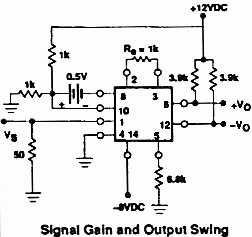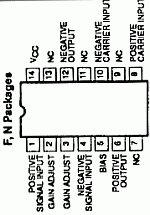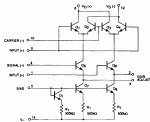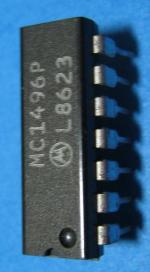
MC1496
|
|
|||||||||||||||||||||||||||||||||
|
Hits: 4360 Replies: 0
MC1496 (MC1496)
|
|
|
Michael Watterson
17.Mar.12 |
1
This is frequently described as a "Gilbert Cell" as it's a standard building block of all modern Radio systems (there could be 8 in a Mobile phone chip!). It's a double balanced Multiplier. The technique certainly pre-dates Barrie Gilbert's 1968 paper (before he worked for Analog) where he was more concerned about linearity and dynamic range for Analogue computation. He didn't mention Radio Mixers. The actual circuit using transistors was described by Morton in "The Review of Scientific Instruments" in Feb. 1966 and using tubes or Transistors by Philips in 1967 "Precision Electronics". The 7360 tube is the same principle of mixer, except it's a single Balanced Multiplier. It was used since 1962. Synchronous vibrator power packs (from 1930s) to get 100V to 500V from a DC battery without a rectifier (metal or tube) on the Transformer HT actually use the same mathematics as do balanced "ring diode" mixers. (two tapped transformers and four diodes in a ring). But two 7360 tubes is virtually the same circuit. Most Superhets used simple non-linear mixers because the cost of a balanced mixer was too high. But telephone FDM and Military equipment did use Balanced Mixers and Doubly Balanced Mixers prior to WWII. The MC1496 was one of the first "popular" IC implementations of a Doubly Balanced Mixer in the 1970s but now with it's high count of external bias resistors and +12V and -8V supply has been superseded long ago by cheaper higher performance parts that may be 5V or 3.3V. My college Final Year Project in 1976 was a chassis to demonstrate filter-less SSB, AM. DSBSC and PM/FM modulation and synchronous PLL demodulation using plug-in cards with MC1496. The MC1496 is now horribly obsolete, but it did make the "Doubly Balanced Mixer" very affordable without the low frequency limit on one input and the output of the ring diode mixer as the MC1496 works to DC on all three ports. The "ring diode mixer" was and still is more expensive but still occasionally used. Minicircuits make miniature surface mount version which is a 6 pin plastic case wiith two transformers using ferrite beads and 4 x matched Schottky diodes
|
End of forum contributions about this tube
| Data Compliance | More Information |




